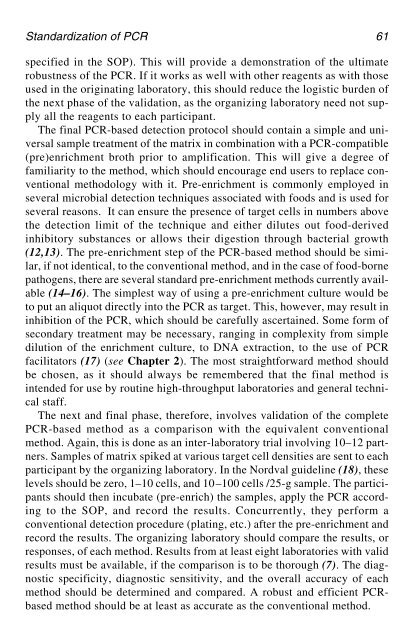PCR Detection of Microbial Pathogens PCR Detection of Microbial ...
PCR Detection of Microbial Pathogens PCR Detection of Microbial ...
PCR Detection of Microbial Pathogens PCR Detection of Microbial ...
You also want an ePaper? Increase the reach of your titles
YUMPU automatically turns print PDFs into web optimized ePapers that Google loves.
Standardization <strong>of</strong> <strong>PCR</strong> 61<br />
specified in the SOP). This will provide a demonstration <strong>of</strong> the ultimate<br />
robustness <strong>of</strong> the <strong>PCR</strong>. If it works as well with other reagents as with those<br />
used in the originating laboratory, this should reduce the logistic burden <strong>of</strong><br />
the next phase <strong>of</strong> the validation, as the organizing laboratory need not supply<br />
all the reagents to each participant.<br />
The final <strong>PCR</strong>-based detection protocol should contain a simple and universal<br />
sample treatment <strong>of</strong> the matrix in combination with a <strong>PCR</strong>-compatible<br />
(pre)enrichment broth prior to amplification. This will give a degree <strong>of</strong><br />
familiarity to the method, which should encourage end users to replace conventional<br />
methodology with it. Pre-enrichment is commonly employed in<br />
several microbial detection techniques associated with foods and is used for<br />
several reasons. It can ensure the presence <strong>of</strong> target cells in numbers above<br />
the detection limit <strong>of</strong> the technique and either dilutes out food-derived<br />
inhibitory substances or allows their digestion through bacterial growth<br />
(12,13). The pre-enrichment step <strong>of</strong> the <strong>PCR</strong>-based method should be similar,<br />
if not identical, to the conventional method, and in the case <strong>of</strong> food-borne<br />
pathogens, there are several standard pre-enrichment methods currently available<br />
(14–16). The simplest way <strong>of</strong> using a pre-enrichment culture would be<br />
to put an aliquot directly into the <strong>PCR</strong> as target. This, however, may result in<br />
inhibition <strong>of</strong> the <strong>PCR</strong>, which should be carefully ascertained. Some form <strong>of</strong><br />
secondary treatment may be necessary, ranging in complexity from simple<br />
dilution <strong>of</strong> the enrichment culture, to DNA extraction, to the use <strong>of</strong> <strong>PCR</strong><br />
facilitators (17) (see Chapter 2). The most straightforward method should<br />
be chosen, as it should always be remembered that the final method is<br />
intended for use by routine high-throughput laboratories and general technical<br />
staff.<br />
The next and final phase, therefore, involves validation <strong>of</strong> the complete<br />
<strong>PCR</strong>-based method as a comparison with the equivalent conventional<br />
method. Again, this is done as an inter-laboratory trial involving 10–12 partners.<br />
Samples <strong>of</strong> matrix spiked at various target cell densities are sent to each<br />
participant by the organizing laboratory. In the Nordval guideline (18), these<br />
levels should be zero, 1–10 cells, and 10–100 cells /25-g sample. The participants<br />
should then incubate (pre-enrich) the samples, apply the <strong>PCR</strong> according<br />
to the SOP, and record the results. Concurrently, they perform a<br />
conventional detection procedure (plating, etc.) after the pre-enrichment and<br />
record the results. The organizing laboratory should compare the results, or<br />
responses, <strong>of</strong> each method. Results from at least eight laboratories with valid<br />
results must be available, if the comparison is to be thorough (7). The diagnostic<br />
specificity, diagnostic sensitivity, and the overall accuracy <strong>of</strong> each<br />
method should be determined and compared. A robust and efficient <strong>PCR</strong>based<br />
method should be at least as accurate as the conventional method.






